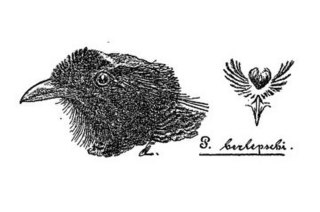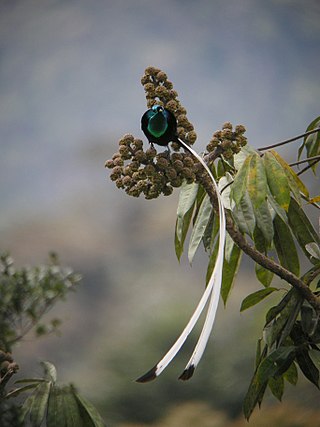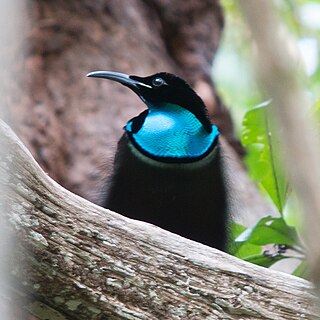
The birds-of-paradise are members of the family Paradisaeidae of the order Passeriformes. The majority of species are found in eastern Indonesia, Papua New Guinea, and eastern Australia. The family has 45 species in 17 genera. The members of this family are perhaps best known for the plumage of the males of the species, the majority of which are sexually dimorphic. The males of these species tend to have very long, elaborate feathers extending from the beak, wings, tail, or head. For the most part, they are confined to dense rainforest habitats. The diet of all species is dominated by fruit and to a lesser extent arthropods. The birds-of-paradise have a variety of breeding systems, ranging from monogamy to lek-type polygamy.

The bronze parotia, also known as the Foja parotia, Berlepsch's parotia or Berlepsch's six-wired bird-of-paradise, is a species of bird-of-paradise, in the family Paradisaeidae. It resembles and is often considered to be a subspecies of Carola's parotia, but a high majority of authorities support its specific status.

The genus Paradisaea consists of six species of birds-of-paradise. The genus is found on the island of New Guinea as well as the nearby islands groups of the Aru Islands, D'Entrecasteaux Islands and Raja Ampat Islands. The species inhabit a range of forest types from sea level to mid-montane forests. Several species have highly restricted distributions, and all species have disjunct distributions. A 2009 study examining the mitochondrial DNA of the family found that the Paradisaea birds-of-paradise were in a clade with the genus Cicinnurus. It showed that the blue bird-of-paradise was a sister taxon to all the other species in this genus.

Astrapia is a genus of birds-of-paradise. The genus contains five species, all endemic to New Guinea. The males have highly iridescent plumage and remarkably long tails. Females are duller and have shorter tails.

The black sicklebill is a large member of the birds of paradise family, Paradisaeidae. This species is found throughout most of central New Guinea and the Vogelkop region to the northwest in montane forests at altitudes from 1,800 to 2,150 m.

Lophorina is a genus of birds in the birds-of-paradise family Paradisaeidae that are endemic to New Guinea, formerly containing a single species, but as of 2017, containing three species.

The magnificent bird-of-paradise is a species of bird-of-paradise. The magnificent bird-of-paradise is evaluated as Least Concern on the IUCN Red List of Threatened Species. They are listed in Appendix II of CITES.

The greater lophorina, formerly a subspecies of the superb bird-of-paradise, is a species of passerine bird in the bird-of-paradise family Paradisaeidae. It is found in the central and northeast montane regions of New Guinea.

Carola's parotia, also known as Queen Carola's six-wired bird-of-paradise or Queen Carola's parotia, is a species of bird-of-paradise.

The western or Arfak parotia is a medium-sized, approximately 33 cm long, bird-of-paradise with a medium-length tail.
The eastern parotia, also known as Helena's parotia, is a medium-sized passerine of the bird-of-paradise family, Paradisaeidae, endemic to mountain forests of the Bird's Tail Peninsula. It is approximately 27 cm long.

The Huon astrapia, also known as Rothschild's astrapia, Huon bird-of-paradise, or Lord Rothschild's bird-of-paradise, is a species of bird-of-paradise belonging to the genus Astrapia. Like most of its congeners, A. rothschildi is a rather elusive member of its genus and family.

Victoria's riflebird, also known as the lesser riflebird, Queen Victoria riflebird, Queen Victoria's riflebird, or Victoria riflebird, is a bird-of-paradise endemic to the Atherton Tableland region of northeastern Queensland, Australia where it resides year-round.

The Splendid astrapia is a species of Astrapia of the birds-of-paradise family, Paradisaeidae, and one of the least known and most elusive of its family and genus.

Wahnes's parotia is a medium-sized passerine of the bird-of-paradise family (Paradisaeidae). This species is distributed and endemic to the mountain forests of Huon Peninsula and Adelbert Mountains, northeast Papua New Guinea. The diet consists mainly of fruits and arthropods.

Lawes's parotia, is a medium-sized passerine of the bird-of-paradise family, Paradisaeidae. It is distributed and endemic to mountain forests of southeast and eastern Papua New Guinea. Occasionally, the eastern parotia is considered a subspecies of P. lawesii. The species is similar to the western parotia.

The magnificent riflebird is a species of passerine bird in the birds-of-paradise family Paradisaeidae.

The genus Ptiloris consists of four allopatric species of birds in the family Paradisaeidae. These birds of paradise are commonly known as riflebirds, so named for the likeness of their black velvety plumage to the uniform of the Rifle Brigade. Alternatively, the bird's cry is similar to a rifle being fired and hitting its target but a call like this is not commonly reported. They are distributed in the rainforests of New Guinea and Eastern Australia.

The growling riflebird, also known as the eastern riflebird, is a medium-sized passerine bird of the family Paradisaeidae.

The Vogelkop lophorina, formerly part of the superb bird-of-paradise complex, is a species of passerine bird in the bird-of-paradise family Paradisaeidae. It is found in montane northwest New Guinea.

























